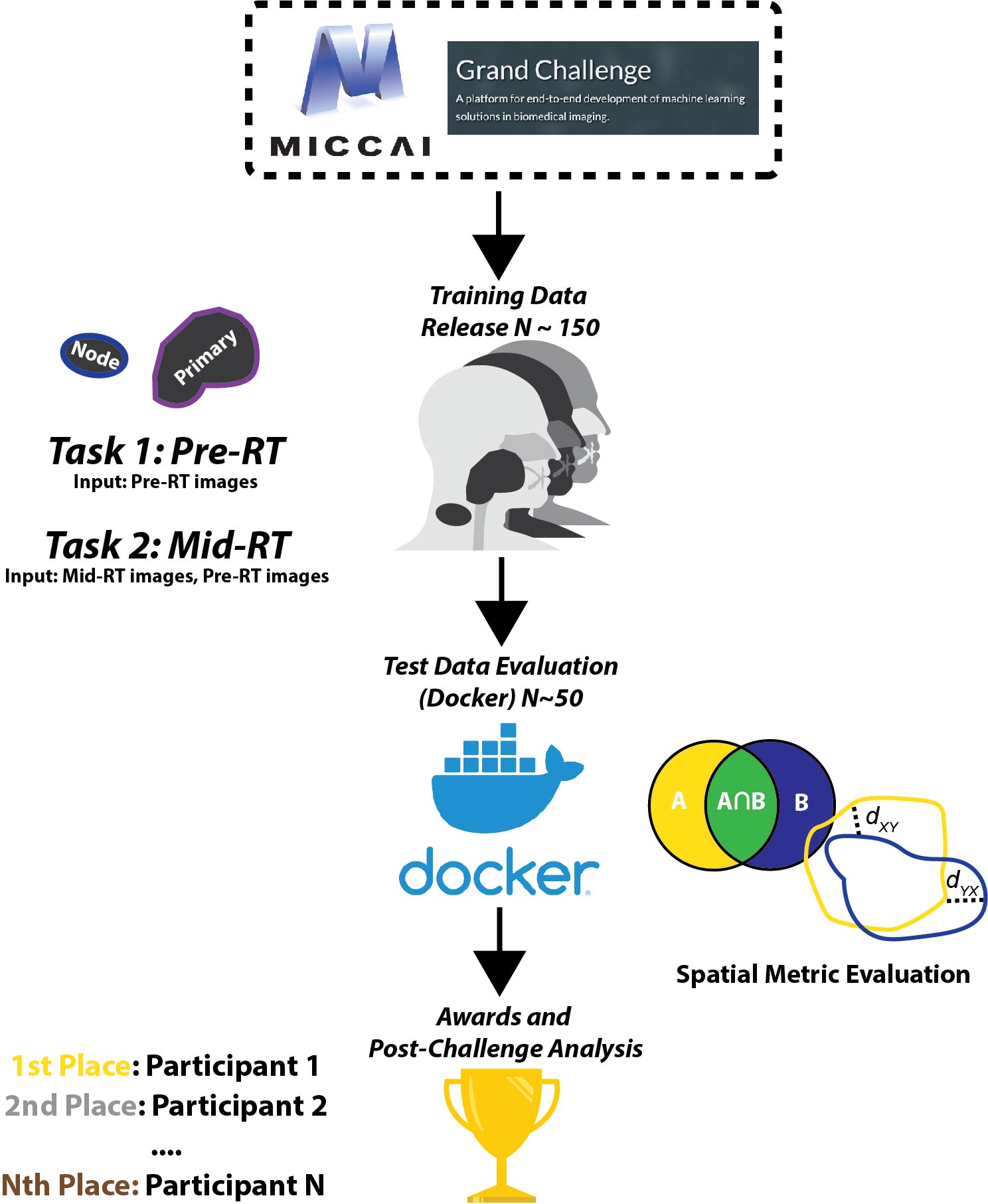Head and Neck Tumor Segmentation for MR-Guided Applications
Note: Many pages on this website are still under construction. These pages should mostly all be finalized by early May.
General Background
Radiation therapy (RT) is a cornerstone of cancer treatment for a wide variety of malignancies. Chief among the beneficiaries of RT as a treatment modality is head and neck cancer (HNC). Recent years have seen an increasing interest in MRI-guided RT planning. As opposed to more traditional CT-based RT planning, MRI-guided approaches afford superior soft tissue contrast and resolution, allow for functional imaging through special multiparametric sequences (e.g., diffusion-weighted imaging [DWI]), and permit daily adaptive RT through intra-therapy imaging using MRI-Linac devices (PMID: 28256898). Subsequently, improved treatment planning through MRI-guided adaptive RT approaches would maximize tumor destruction while minimizing side effects. Given the great potential for MRI-guided adaptive RT planning, it is anticipated that these technologies will transform clinical practice paradigms for HNC (PMID: 31632914).
The extensive data volume for MRI-guided HNC RT planning makes manual tumor segmentation by physicians — the current clinical standard — often impractical due to time constraints (PMID: 33763369). This is compounded by the fact that HNC tumors are among the most challenging structures for clinicians to segment (PMID: 27679540). Artificial intelligence (AI) approaches that leverage RT data to improve patient treatment have been an exceptional area of interest for the research community in recent years. The use of deep learning in particular has made significant strides in HNC tumor auto-segmentation (PMID: 36725406). These innovations have largely been driven by MICCAI public data challenges such as the HECKTOR Challenge (PMID: 35016077), and the SegRap Challenge (doi: https://doi.org/10.48550/arXiv.2312.09576). However, to-date, there exist no large publicly available AI-ready adaptive RT HNC datasets for public distribution. It stands to reason that community-driven AI innovations would be a remarkable asset to developing technologies for the clinical translation of MRI-guided RT.
In this data science challenge, we focus on the segmentation of HNC tumors for MRI-guided adaptive RT applications. The challenge will be composed of 2 tasks focused on automated segmentation of tumor volumes on 1. pre-RT MRI images and 2. mid-RT MRI images. Our challenge is particularly unique as it seeks to ascertain whether incorporating prior timepoint data into auto-segmentation algorithms leads to enhanced performance for RT applications.

Figure 1. General overview of this data challenge.
Post-Challenge Details
At the conclusion of this challenge, all training and testing data will be made publicly available through The Cancer Imaging Archive (TCIA). This will be accompanied by a detailed data descriptor, which we plan to submit to Nature Scientific Data or another appropriate publisher.
References
- Cardenas, Carlos E., Sanne E. Blinde, Abdallah S. R. Mohamed, Sweet Ping Ng, Cornelis Raaijmakers, Marielle Philippens, Alexis Kotte, et al. 2022. Comprehensive Quantitative Evaluation of Variability in Magnetic Resonance-Guided Delineation of Oropharyngeal Gross Tumor Volumes and High-Risk Clinical Target Volumes: An R-IDEAL Stage 0 Prospective Study. International Journal of Radiation Oncology, Biology, Physics 113 (2): 426 to 36.
- Hindocha, S., K. Zucker, R. Jena, K. Banfill, K. Mackay, G. Price, D. Pudney, J. Wang, and A. Taylor. 2023. Artificial Intelligence for Radiotherapy Auto-Contouring: Current Use, Perceptions of and Barriers to Implementation. Clinical Oncology 35 (4): 219 to 26.
- Kiser, Kendall J., Benjamin D. Smith, Jihong Wang, and Clifton D. Fuller. 2019. Après Mois, Le Déluge: Preparing for the Coming Data Flood in the MRI-Guided Radiotherapy Era. Frontiers in Oncology 9 (September): 983.
- Langerak, Thomas Robin, Uulke A. van der Heide, Alexis N. T. J. Kotte, Max A. Viergever, Marco van Vulpen, and Josien P. W. Pluim. 2010. Label Fusion in Atlas-Based Segmentation Using a Selective and Iterative Method for Performance Level Estimation (SIMPLE). IEEE Transactions on Medical Imaging 29 (12): 2000 to 2008.
- Lin, Diana, Kareem A. Wahid, Benjamin E. Nelms, Renjie He, Mohammed A. Naser, Simon Duke, Michael V. Sherer, et al. 2023. E Pluribus Unum: Prospective Acceptability Benchmarking from the Contouring Collaborative for Consensus in Radiation Oncology Crowdsourced Initiative for Multiobserver Segmentation. Journal of Medical Imaging (Bellingham, Wash.) 10 (Suppl 1): S11903.
- Luo, Xiangde, Jia Fu, Yunxin Zhong, Shuolin Liu, Bing Han, Mehdi Astaraki, Simone Bendazzoli, et al. 2023. SegRap2023: A Benchmark of Organs-at-Risk and Gross Tumor Volume Segmentation for Radiotherapy Planning of Nasopharyngeal Carcinoma. arXiv [eess.IV]. arXiv. http://arxiv.org/abs/2312.09576.
- Pollard, Julianne M., Zhifei Wen, Ramaswamy Sadagopan, Jihong Wang, and Geoffrey S. Ibbott. 2017. The Future of Image-Guided Radiotherapy Will Be MR Guided. The British Journal of Radiology 90 (1073): 20160667.
- Schwarz, Christopher G., Walter K. Kremers, Arvin Arani, Marios Savvides, Robert I. Reid, Jeffrey L. Gunter, Matthew L. Senjem, et al. 2023. A Face-off of MRI Research Sequences by Their Need for de-Facing. NeuroImage 276 (August): 120199.
- Segedin, Barbara, and Primoz Petric. 2016. Uncertainties in Target Volume Delineation in Radiotherapy - Are They Relevant and What Can We Do about Them? Radiology and Oncology 50 (3): 254 to 62.
- Thorwarth, Daniela, and Daniel A. Low. 2021. Technical Challenges of Real-Time Adaptive MR-Guided Radiotherapy. Frontiers in Oncology 11 (March): 634507.
- Wahid, Kareem A., Sara Ahmed, Renjie He, Lisanne V. van Dijk, Jonas Teuwen, Brigid A. McDonald, Vivian Salama, et al. 2022. Evaluation of Deep Learning-Based Multiparametric MRI Oropharyngeal Primary Tumor Auto-Segmentation and Investigation of Input Channel Effects: Results from a Prospective Imaging Registry. Clinical and Translational Radiation Oncology 32 (January): 6 to 14.
